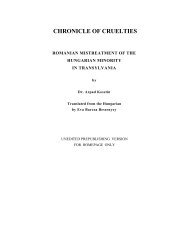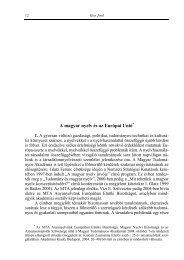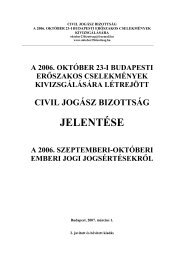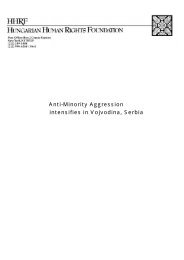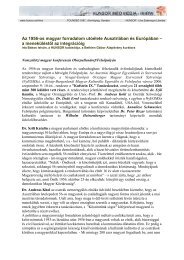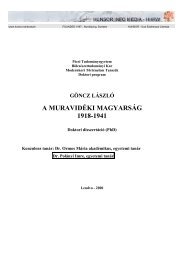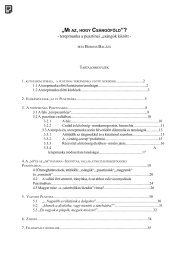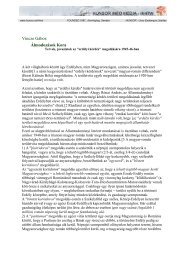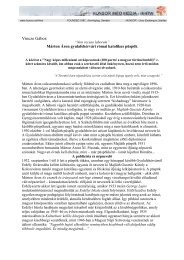26that those people all fell victim to murder innocently.""Nothing more? Don´t you want to search for the murderers, to catch them?""The murderers can't be found anyway, they have hidden and those who could haveremembered, who could have testified were all killed by them. I have never heard and neverread about anybody who knows how many people perished in each place, because people areafraid to talk: they are all frightened even to remember those days. The authorities in Bacskastrictly forbid anybody to recall it and those who try to speak about these events are arrested.We are allowed to remember and to speak only about what happened in Novi Sad." At thispoint he put his hand on my <strong>book</strong>, "and you can write only about that, too, although...""Yes, you´re right, "I admitted. "Even here in our country we are allowed to rememberonly those crimes we committed or which were committed in our name in January 1942.According to the Hungarian government, the rest should be forgotten since, it was consideredjust retaliation and therefore not mentioned even at the peace negotiations.""But it was not just because lots of innocent people were slaughtered!"My Bezdan man drank up his wine with one gulp and grew extremely agitated."<strong>This</strong> silence which was ordered on us afflicts us Hungarians the most! Can you imagineanybody who can forget everything that is good about his own people and everything that isevil about other nations? Anybody who is willing to remember his crimes only and forgets allgood deeds, all excuses but regards the enemy as pure, innocent and faultless almost to theextent of glorification. Even if he remembers an evil deed he declares it an inevitable, brave,heroic act, although he is well aware that such bloodshed is far from being brave heroism."I was surprised and became suspicious that he was aiming at accusing me for my <strong>book</strong>.All I said, however, was that I felt the danger and the absurdity of the orders requiring silence,but I hoped that there would be a brave Serbian writer, who would write the story of the deedsthe Serb partisans committed in the name of his nation in Bacska during the autumn of 1944.After a brief period of thought, the man said the following:"No Serb will ever confess to what happened in Bezdan and in Bacska.""So you want a kind of revenge after all!""No! Not revenge! There´s no one to revenge and no one to take revenge on. I will notgo to court nor will I take up arms. I just feel sorrow for my little brother who died in the riverwithout knowing a man's life at all. Had I known beforehand what would happen to him, Iwould rather have gone with my father and sent him away to our sister in Baja.""Is that all?""And don´t forget to mention that the other one hundred and sixteen people were allinnocent as well."I decided to satisfy his wish and, as a first step, to make public what I had learned fromhim about the vengeance of the partisans and about the innocent people of Bezdan. I askedhim where I could find him if I wanted to know something more about that autumn."It's better not to find me, or if they happened to learn that it was me who gave theinformation and broke the order of silence, I could go home no more and if I tried, they wouldkill me."
We bade farewell with a strong handshake. Although he had learned in front of the tentthat a dedication is a "gift" of honour from the writer to the reader, he did not wish to obtain iteven after our conversation. Only later did I understand that he was afraid of telling me hisname. He felt that even this could be dangerous for him.I put down the story of my meeting with the Man of Bezdan on the same day. A coupleof days later, I told the audience of the University Theatre all I knew about the murder of the118 people. My audience was shocked by this unknown tragedy.I hoped that I could publish the account of this experience soon after the appearance of"Cold Days". Unfortunately, only years later could I find a periodical, "Kortars" whichdared to publish the story the Man of Bezdan told me. Our mutual boldness was followed byan international diplomatic conflict, Tito's impending visit to Budapest was postponedbecause of us and the association of Yugoslav partisans declared me persona non grata.That was the reaction to breaking the obligatory silence.2.Dr. Andras Varga, an engineer by profession and head of the department at theUniversity of Heidelberg, came to Germany from Bacska. Fortunately, he does not have toworry about the vengeful retaliation and, as a "foreigner", he was able to gather a lot ofinformation about the events of that horrible autumn including the massacre in Bezdan. Healso managed to identify28the bloodthirsty and murderous Serbian partisan squad. He shared his knowledge and theresults of his research with Miklos Zelei, who published the still dangerous historical data inthe Sept. 15, 1990 issue of the weekly "Kepes 7".According to the Hungarian professor, the Hungarian armed forces, the police and thegendarmerie abandoned the city of Subotica (Szabadka) in northern Bacska on Oct. 8, 1944,and the Soviet troops marched in from the direction of Szeged on Oct. 14. They reachedZombor on Oct. 20, and Novi Sad two days later, on Oct. 22. The Serbian troops, the partisansquads of Tito, infiltrated Bacska only after the fight ended in the region.The report pays special attention to Bezdan, this Hungarian village on the left bank of theDanube. To the best of Dr. Varga´s knowledge, the villagers, men, women and children alike,were summoned to the soccer field at 9 a.m. on Nov. 3, 1944, under the pretext that importantpublic works should be carried out and therefore everybody must show up under penalty ofdeath. The partisans separated all 18 and 19 year-old young men from the crowd, includingthe players of the well-known soccer team, the BFC. By this cynical move, the partisancommander wanted to mislead the remaining population and make it possible to drive thegroup away without disturbance.Equipped with spades and hoes, 122 men were led along the road to Zombor to the edgeof the Isterbac woods. Armed with machine guns, only 15 partisans escorted the obedient andslightly worried group. Once there, they were forced to dig two large, wide pits, each 2 metersdeep. At that point, some of them may have begun to suspect the purpose of the work. Theirapprehension could have been reinforced by the fact that a kind-hearted partisan tried to send
- Page 3 and 4: Library of Congress Catalogue Card
- Page 5 and 6: Mutilation of the hands or feet wit
- Page 7 and 8: they wanted to belong. On the annex
- Page 9 and 10: individuals, then shooting them by
- Page 11 and 12: the Russians and under their protec
- Page 13 and 14: 22PEOPLE OF BEZDAN1.On a May aftern
- Page 18 and 19: ack a 13 year-old boy to the soccer
- Page 20 and 21: Russian officers cursed and told th
- Page 22 and 23: Jani was set free for he had been a
- Page 24 and 25: There were some people who, in spit
- Page 26 and 27: March 12, 1945. The relatives of th
- Page 28 and 29: Ferenc Csapo, 33 Mihaly Miovacs, 18
- Page 30 and 31: Having heard about the advance of t
- Page 32 and 33: "On November 3, I got up at five in
- Page 34 and 35: The vicar would come every night. H
- Page 36 and 37: hand. Raising it to his mouth, he d
- Page 38 and 39: "24th October, 1944. Yesterday was
- Page 40 and 41: "I have only one chance to be sacri
- Page 42 and 43: The data, which shows that on the s
- Page 44 and 45: all the captured Serbs, as neither
- Page 46 and 47: Before and during World War II, the
- Page 48 and 49: would order fire in an instant. Wit
- Page 50 and 51: Our house looked out over the main
- Page 52 and 53: He had just arrived home after thre
- Page 54 and 55: 28. Jozsef Pasztor, 34 56. Albert G
- Page 56 and 57: The OZNA officer, who exhumed a mas
- Page 58 and 59: 7917 year old Karoly and 8 year old
- Page 60 and 61: 82FROM SZENTFULOP TO THE GAKOVA CAM
- Page 62 and 63: My mother died on January 4, 1946.
- Page 64 and 65: Jozsi, the leader of our committee
- Page 66 and 67:
his own grave, then machine gunned
- Page 68 and 69:
driving a wheelbarrow on the sidewa
- Page 70 and 71:
"Now that's exactly what we needed
- Page 72 and 73:
15 Istvan Polyakovics, Zenta, 18861
- Page 74 and 75:
idge was built (from several rows o
- Page 76 and 77:
There is a common opinion among the
- Page 78 and 79:
The Catholics of the village were o
- Page 80 and 81:
and their supporters. On one occasi
- Page 82 and 83:
"My younger brother, Bandi, was tak
- Page 84 and 85:
two young instructors staying in he
- Page 86 and 87:
In Tunderes (Vilova) there was no o
- Page 88 and 89:
weeks spent starving, laying on str
- Page 90 and 91:
121PACSERAt Pacser sixteen Serbians
- Page 92 and 93:
piece of land, there are three rows
- Page 94 and 95:
"I understood that through the OZNA
- Page 96 and 97:
took the priest under their protect
- Page 98 and 99:
"We set off from Hadikliget on Octo
- Page 100 and 101:
everyone to the front! The Party us
- Page 102 and 103:
137REPORT OF LOSSESIn addition to o
- Page 104 and 105:
141Source: Zlocini okupatora u Vojv
- Page 106 and 107:
well as in words, that there had be
- Page 108 and 109:
The American military forces delive
- Page 110 and 111:
culpability or participation are th
- Page 112 and 113:
The accused did not make use of his
- Page 114 and 115:
the spirit of revenge among the Hun
- Page 116 and 117:
considered all the claims of Hungar
- Page 118 and 119:
The People's Court of Budapest just
- Page 120 and 121:
From then on all hell breaks loose.
- Page 122 and 123:
Recommended readingeRudolf Kiszlion



